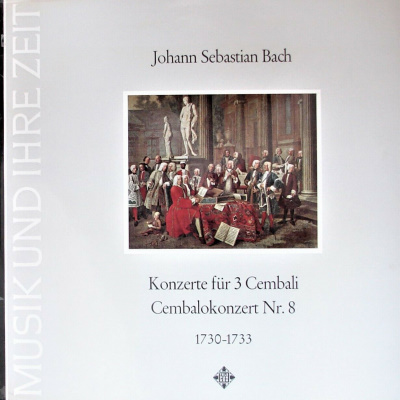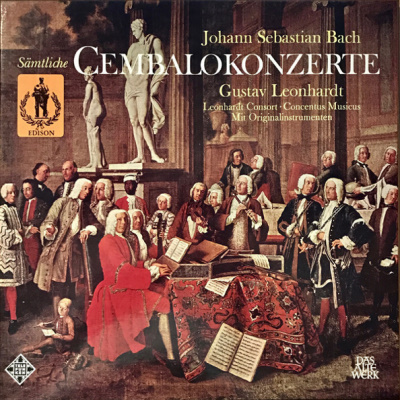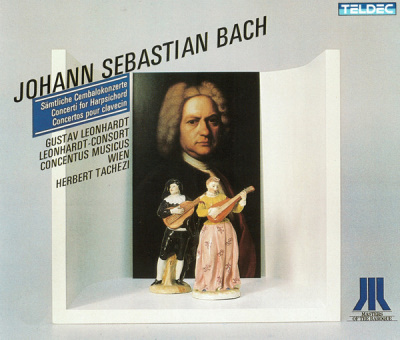 |
|
1 LP -
SAWT 9458-A - (p) 1964
|
 |
| 5 LPs -
SCA 25022-T/1-5 - (c) 1972 |
 |
| 2 CDs -
8.35778 XD - (c) 1989 |
|
| KONZERTE FÜR 3
CEMBALI & CEMBALOKONZERTE |
|
|
|
|
|
|
|
| Johann Sebastian
BACH (1685-1750) |
Konzert
für 3 Cembali d-moll, BWV 1063 - 2
Violinen, Viola und Continuo
|
|
13' 30" |
|
|
-
(Allegro)
|
4' 57" |
|
A1
|
|
- Alla Siciliana
|
3' 53" |
|
A2
|
|
-
Allegro
|
5' 04" |
|
A3 |
|
Konzert
Nr. 8 d-moll für Cembalo, BWV 1059 -
Oboe, 2 Violinen, Viola und Continuo
(Rekonstrution: Gustav Leonhardt) *
|
|
15' 00" |
|
|
-
(Allegro)
|
6' 30" |
|
A4 |
|
-
Adagio (Cembalo ad libitum)
|
1' 06" |
|
B1 |
|
-
Presto
|
3' 42" |
|
B2 |
|
Konzert
für 3 Cembali C-dur, BWV 1064 - 2
Violinen, Viola und Continuo |
|
17' 00" |
|
|
-
Allegro |
6' 23" |
|
B3 |
|
-
Adagio |
5' 49" |
|
B4 |
|
-
Allegro
|
4' 40" |
|
B5 |
|
|
|
|
|
Gustav
LEONHARDT, Cembalo *
Anneke UITTENBOSCH, Cembalo
Alan CURTIS, Cembalo
|
DAS
LEONHARDT-CONSORT
- Marie Leonhardt, Antoinette van den
Hombergh, Violine
- Wim ten Have, Lodewijk de Boer, Viola
- Dijck Koster, Violoncello
- Fred Nijenhuis, Kontrabaß
Gustav LEONHARDT, Leitung
|
Instrumente:
- Cembalo I (Martin Skowroneck, Bremen 1962,
nach J. D. Dulcken, Amsterdam 1745)
- Cembalo II und III (Martin Skowroneck,
Bremen 1963 nach J. D. Dulcken, Amsterdam
1745)
- Violine (Jakob Stainer, 1676)
- Violine (Klotz, 18. Jahrh.)
- Viola (Giovanni Tononi, 17. Jahrh.)
- Viola (deutsch, 18. Jahrh.)
- Violoncello (Giovanni Battista [II]
Guadagnini, 1749
- Kontrabaß (deutsch, 18. Jahrh.)
Alle Instrumente in Barockmensur
Stimmung ein Halbton unter normal
|
|
|
|
|
|
Luogo
e data di registrazione |
|
Hervormde Kerk,
Bennebroek (Holland) - 9/12
Ottobre 1963
|
|
|
Registrazione: live
/ studio |
|
studio |
|
|
Producer |
|
Wolf Erichson
|
|
|
Prima Edizione LP |
|
Telefunken "Das Alte
Werk" | SAWT 9458-A (Stereo) - AWT
9458-A (Mono) | 1 LP - durata 41'
30" | (p) 1964 | ANA
Telefunken
"Das Alte Werk" | SCA
25022-T/1-5 | 5 LPs - durata
212' 39" | (c) 1972 | ANA | (Sämtliche
Cembalokonzerte)
|
|
|
Edizione CD |
|
Teldec Classics |
LC 3706 | 8.35778 XD | 3 CDs -
durata 76' 42" - 72' 00" - 63'
57" | (c) 1989 | ADD |
(Sämtliche Cembalokonzerte) |
|
|
Cover
|
|
- |
|
|
Note |
|
"Hofmusik in
ismaning", aus dem Gemälde von
Peter Jakob Horemans (Original in
Bayerischen Nationalmuseum,
München).
|
|
|
|
|
Bach’s two
concertos for three
harpsichords have long been
widely known and admired by
music lovers - already in
1840, Liszt, Mendelssohn,
and Hiller performed the D
minor Concerto at the
Leipzig Gewandhaus with
acclaim. Seldom, however, in
this past century and a
quarter have the concertos
been heard in a manner at
all closely resembling their
composer’s intention. Until
recently, the convergence of
three harpsichords was in
itself a rarity, and even
today the assembling of
three individual and
authentic instruments of
‘equal strength is most
unusual, although vitally
essential to the proper
balance of the work. The
present recording employs
three very similar but not
identical harpsichords
which, unlike most modern
instruments, reproduce the
full resonance and quality
of tone usual in Bach’s day.
They are complemented not by
a modern string orchestra,
but by a small complement of
soloists, whose Baroque
instruments blend, or
occasionally sing out, but
never enshroud with a heavy
mantle of vibrato sound the
clarity and brilliance of
the solo parts. The addition
of a fourth harpsichord for
the continuo, declared
necessary by certain German
scholars, is unjustified and
superfluous in these
concertos. In the few
figured bass passages
(second movement of the C
major) the continuo function
may be divided among the
three keyboards, at the
discretion of the
performers. More problematic
is the division of parts in
the second movement of the D
minor. Here the beautifully
lilting melody, in the
rhythm of a siciliano, has
come down to us scored for
violin doubled - or rather
quadrupled - by all three
harpsichords, whose parts
are pedantically identical
in the tuttis. Such
heavy-handed doubling is
most un-Bachian, and even if
this piece is not his, would
be puzzling in a work
otherwise of such quality.
It is hardly surprising to
learn that this movement has
been preserved not in an
autograph, but only in
copies made long after
Bach’s death. Probably the
doubling was the work of an
unimaginative copyist no
longer accustomed to
continuo practice. This
recording restores the
melody to the violin and an
accompanying role to the
harpsichords.
The man to whom we owe the
most authentic copy of these
two concertos was Johann
Gottfried Palschau
(1741-1813), a keyboard
player and composer born in
Hamburg, who travelled to
Riga, studied there with
Bach’s well-known pupil,
Müthel, and settled in
Petersburg. We might well
imagine that he obtained
copies of the concertos from
Müthel, and that therefore
the ascription to J. S. Bach
is to be accepted. No
scholar has yet brought
forth credible evidence to
the contrary. It is all the
more remarkable, then, to
find that Palschau omits the
alla siciliana
movement from his otherwise
careful copy. It is not only
the doubling which makes
this movement dubious. The bel
canto cadential
figures are the work of a
German with sympathies for
Italian opera (more
Handelian than Bachian), and
the form - 8-bar tutti,
8-bar solo, 24-bar tutti,
24-bar solo, cadenza - is
very unlike Bach’s
sicilianas or other slow
movements. Could it have
been written by Wilhelm
Friedemann, whose concerto
for two harpsichords long
passed for the work of his
father? We can never be
certain. Nor shall we ever
know whether these concertos
were original compositions
or transcriptions. Prof.
Schering felt the C major
must have originally been
written for three violins,
because of solo passages
where the left hands are
doubled, the right hands
varied. However; the
opposite is also
occasionally true, and the
extraordinary sound of
measures 80-85 of the first
movement, with its
independently arpeggiated
bass lines in the solo left
hands, would be quite
impossible in another
medium. In the last movement
of the D minor, moreover,
the unusually long, driving
sequence of the first
harpsichord would be
unthinkable on anything but
a keyboard: the upper line
alone covers a range of
three and a half octaves of
unbroken sixteenths.
At the end of the autograph
manuscript of Bach’s seventh
Harpsichord Concerto is the
beginning of an eighth.
After nine measures, just
when the solo is to enter,
the fragment ends. The loss
of the rest, after such a
tantalizing opening, has
given rise to the
lamentations of Bach
scholars - and to the
remarkable reconstruction by
Gustav Leonhardt here
recorded. The nine measures
correspond with the opening
of Cantata 35, “Geist und
Seele wird verwirret”
(1726), though Bach has
dropped the second oboe and
the taille. Moreover, in the
fourth measure he has
drastically altered the
theme by adding syncopations
and upward scalar sweeps, an
intensification which
astounds us as a stroke of
genius and surely indicates
that the concerto followed
the cantata (though Spitta,
II, 278, strangely assumed
the opposite). Leonhardt has
revised the instrumental
parts of the cantata along
the lines indicated by the
fragment and, with the
obligato organ part as a
basis, invented an idiomatic
harpsichord part as Bach, or
another 18th-century
performer, might have done.
Inasmuch as the Seconda
Parte of the same
cantata is opened by another
instrumental Sinfonia
with organ solo, it seems
likely that this would have
formed the last movement of
the concerto. The orchestral
parts are practically
unaltered in Leonhardt’s
version. Spitta’s notion
that the opening da capo
aria for alto would have
served as middle movement
seems untenable, most
obviously for formal
reasons. For lack of a
full-length movement,
Leonhardt has improvised a
prelude to an orchestral
Phrygian cadence, parallel
to that in the Third
Brandenburg Concerto.
The most likely use for
harpsichord concertos in
Bach’s Leipzig activities
would have been the weekly
meetings of the Collegium
Musicum founded by Telemann
and taken over by Bach in
1729. It is pleasant to
think of him presiding at
the Friday evening sessions,
where Gottfried Zimmermann’s
coffee-house on
Catherinenstrasse would have
been jammed full of
harpsichords and - one hopes
- some appreciative
coffee-drinking students. As
Bach’s secretary enticingly
wrote to a friend in 1739,
“...he will begin the
Collegium Musicum this
Friday, and will perform
some music in the first week
of the Fair for the birthday
of His Royal Majesty. It
will certainly be worth
listening to.”
Alan
S. Curtis
|
  |
|
|